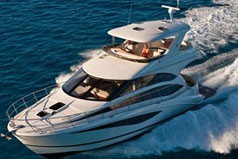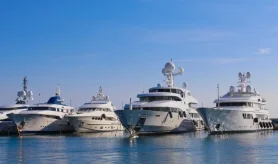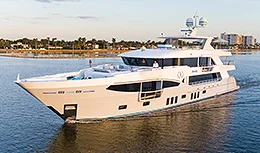- Alaskan Yachts
- Azimut Yachts
- Back Cove Yachts
- Beneteau Yachts
- Benetti Superyachts
- Bertram Yachts
- Boston Whaler
- Broward Yachts
- Buddy Davis Sportfish
- Burger Yachts
- Cabo Yachts
- Catamarans
- Carver Motoryachts
- Center Console
- Chris-Craft Yachts
- Cruisers Yachts
- DeFever Trawlers
- Dufour Sailboats
- Fairline Yachts
- Feadship Yachts
- Ferretti Yachts
- Filippetti Yachts
- Formula Yachts
- Fountaine Pajot Cats
- Grady-White
- Grand Banks Trawlers
- Hargrave Yachts
- Hatteras Yachts
- Hinckley Picnic Boats
- Horizon Yachts
- Hydra-Sports
- Intrepid Boats
- Jarrett Bay Sportfish
- Jeanneau Yachts
- Kadey-Krogen Trawlers
- Lazzara Yachts
- Lekker Boats
- Luhrs Sportfish
- Marlow Yachts
- Maritimo Yachts
- Marquis Yachts
- Mazu Yachts
- McKinna Motoryachts
- Meridian Yachts
- Midnight Express
- MJM Yachts
- Mochi Craft
- Neptunus Motoryachts
- Nordhavn Trawlers
- Nordic Tugs
- Numarine Yachts
- Ocean Alexander Yachts
- Ocean King
- Offshore Yachts
- Outer Reef
- Oyster Sailing Yachts
- Pacific Mariner Yachts
- Palmer Johnson Yachts
451 Meridian Sedan 2011
![]()

Source: Power & Motoryacht Magazine
The Mission
The Meridian 541 has been designed for serious coastal cruising for two or three couples or a large family. It is not hard to picture this boat running out of Long Island Sound to go up to Nantucket for a week of cruising, or exploring the Chesapeake Bay, Puget Sound, or even the Dalmatian Coast, the Bahamas, or hopping along the Riviera in the Med.
Like all Meridian models, part of the mission is to provide all of the above at a competitive price.
First Look
I caught my first glimpse eight months ago of the Meridian 541 Sedan as I was finishing up a test on another boat. The 541 had just pulled in as I was getting ready to leave, so I waited around for the boat to be tied up, and then being the nosy captain that I am, stepped aboard for a self guided tour.
I immediately fell in love with the layout: It’s definitely unique, and so sensible. High marks to Meridian for designing this one and I predict it will be a very popular model. I knew we were scheduled to test this model sometime, but the problem was getting our hands on one! They’re actually selling as fast as they come off the line, and no one wants to wait to take delivery while the builder spends a day or two testing. Until now…eight months later…
Handling
The 541 Sedan has a very solid feel, and I would almost describe it as sporty. Pod drives usually add about 30% to the fuel economy of a boat at best cruise, and they also substantially improve handling. Therefore, I expected a lot going into this test.
Note the lines of the Meridian 541 and its transition from an express cruiser to a large sedan motoryacht.
Tracking was straight and true as I hit the throttles, bow rise was minimal and no factor on visibility due to our high helm position. Putting the 541 into hard turns at speed was where the sporty handling came in. She responds instantly to the helm and the turn is initiated with a spry roll into the turn of about 10-degrees. Once the turn is established, she rolls back to about 7-degrees and stays there until you return the helm. It can be a little disconcerting having this large a boat roll into the turn that fast, but after doing it once, you no longer feel cautious and just start letting the wheel fly. With power steering, a fingertip is all the effort you need to send the 541 into any maneuver you desire.
Close Quarters
Around the dock, there are no surprises. Pods have been around long enough for everyone to know how effortlessly they turn docking a boat into a non-event. I did find that the wheel would turn a bit, roughly 1/8 turn, due to torque as I was maneuvering the joystick, but not enough to affect the handling, or direction of the maneuvers. When coming into the dock, the starboard mounted helm gives you a natural commanding view of the starboard side. You also have a clear view of the starboard quarter by looking down the stairs to the cockpit.
With our dock on the port side, I slid the 541 into the slip while keeping close to the starboard side pilings. Once into the slip, it was simply a matter of sliding the 541 to port and I laid her up gently against the dock… pretty as you please. If anyone has any trepidation about being able to handle a boat this big, rest assured…you can. Do not let the size hold you back.
Station Keeping
The Zeus pod system was also equipped with Skyhook. This is a version of a GPS-based position keeping system, and it works by touching a single button, cleverly labeled “Skyhook”. It worked well enough to hold our position in a roomy environment, but when things start to get squeezed in, not so much. I wouldn’t hesitate to use this feature while waiting for a drawbridge to open, holding off for a fuel dock, or perhaps while getting lines out in preparation for docking.
I found that the system does allow movement, and then recognizes that movement, and ultimately moves the boat back into the original position. For that reason, do not expect to use the system for allowing a single person to leave the helm while tying up to a dock. It isn’t that sensitive and that’s poor seamanship anyway.
Autopilot
The Zeus system also includes an autopilot that worked very well. For making incremental changes to your heading you have two choices: a pair of arrowed buttons on the system panel for left and right deviations will alter your heading in 10-degree increments; touch the side of the joystick to alter your course by 1-degree.
Performance
We reached a top speed of 34.9 mph at 2500 rpm with a fuel burn of 67.6 gph. At that speed we were getting .52 mpg for a range of 294 miles. The numbers show best cruise to be at 2000 rpm and 24.8 mph. That generated a 43.7 gph fuel burn getting .57 mpg, and a range of 323 miles.
However, I suspect that the average operator will be spending his/her time at 2200 rpm. That delivered a speed of 29.2 mph and a fuel burn of 53 gph for .55 mpg. The penalty in range was only 9 miles from the “best cruise” speed, and therefore I seriously doubt that anyone will care. Also, when I was operating the 541, after accelerating my hand settled the throttles more often than not at 2200 rpm. To me, that’s where the boat “felt” most comfortable. And with only a minor fuel penalty, that’s where I’d be spending my time.
Time to plane was 9.5 seconds, and we reached 20 mph in 12 seconds.
Unique Features
In my opinion, the folks doing the interior designing for Meridian are very innovative. And their designs are usually quite practical. The Meridian 541 is a prime example. The forward, raised salon is a remarkable design concept. While seated, everyone can see out rather than being down in a cave. The galley aft, with a retractable window to the cockpit and aft deck, makes serving al fresco lunch handy and minimizes the chance of spilled drinks.
Many inboard builders have been slow to adapt to the new pod drive technology, but I’m glad to see that Meridian has jumped onto the Zeus pod drive system –in addition to making the boat go faster, burn less fuel and make joystick docking possible, it also moves the engines aft, leaving room forlarger living accommodations.
Simply compare this boat to conventional inboard-powered boats in this class and you will see what I mean.
Design
In comparing the 541 with seven other sedans in class built both in Europe and in the U.S., we find remarkable similarities in basic specifications. All have a beam from 14’3″ (4.38 m) to 16’2″ (4.97 m), with the Meridian — at 15’6″ (4.76 m) — being a little wider than average. The displacement of these seven vessels ranges from 32,000 lbs. (14,545 kgs.) to 62,000 lbs. (28,181 kgs.). Again the 541 is in the middle, weighing more than two other boats and less than two others and about the same as three others in the middle. She weighs 52,000 lbs. (23,587 kgs.) dry.
It seems that Meridian has been careful to stay in the center of the competition in regard to the size and weight of the boat so that it can perform and be priced competitively with the competition.
The galley and dinette are situated in the aft end of the house, unusual but very practical.
Accommodations
All eight of the competing boats I looked at in this 54′ range of sedans have two or three staterooms with two or three heads. Most do not have crew’s quarters. In the 541, access to the crew’s quarters, should you decide to go with that configuration, is through a hatch in the engine room, or one in the galley sole. Here, the battery banks are on shelves with roller bearings to make it easy to check water levels.
Obviously a mate will not be thrilled to have to move through a hot engine room to get to his cabin, but just imagine how good the A/C will feel once he gets there. In the morning, crawling out through the engine room is a good thing as the captain or mate will be reminded to check all of the fluids before his morning java.
The queen bed (with inner spring mattress) is placed on the diagonal in the full beam master.
I suspect that most owner/operators will simply use the space between the engine room and the master for storage and other, optional equipment. Remember that the engines are now in the space normally occupied by the lazarette, so you will need stowage room, and there’s plenty of it here.
Pros and Cons
Clearly, the big pros of this boat are its main deck layout, the pod drive system with joystick, and the added accommodations made possible with the engines moved aft. The base MSRP price of $1,268,000 is also a big “pro.”
The cons of the boat probably have more to do with one’s personal preferences and sense of styling than anything else, in our opinion. For example, since this is a cruising boat, some people might want a boat that looks like a more traditional cabin cruiser, convertible or motoryacht, rather than one that looks like a large Euro-styled express cruiser. On the other hand, Meridian is the largest builder of flying bridge sedans in the U.S., so it has clearly hit a responsive chord among consumers.
Considerations
Most people will want to have a tender. Because the helm is on the flying bridge and not below, one could have the tender on the bow and launch it with a davit. But because of the design of the foredeck with a raised center section and places for sun pads, this approach is problematic. One could have a conventional mechanical davit on the stern and raise the tender on its side, bottom aft.
Alternatively, the hydraulic platform, offered as a factory option by Meridian, that will raise and lower the tender is the best solution. While the aesthetics of this arrangement may take some getting used to, it is very functional and makes a huge swim platform which is also a great place for staging scuba diving trips. It in fact becomes a virtual cockpit/beach for all sorts of water sports.
One of the nice features of the hydraulic platform for the tender is that is can be lowered to water level for all sorts of activities. Both kids and adults will love using it.
There is a reason why large convertibles fiberglassed over their windshields some 30 years ago: to reduce heat in the main cabin and to stop window leaks. Modern boatbuilding techniques have solved the leak problem. Visibility is great from the 541’s raised forward saloon, but in bright sunshine that area is going to be hot without shades. Meridian includes as standard equipment a black mesh cover that goes over the windshields.
If you prefer, there is an optional lower helm station available.
Recommendation
As previously noted, many boats in this class do not have pod drives, which are definitely a more expensive propulsion system, yet Meridian has managed to stay competitive in price even with them. MSRP is $1,268,000.
The hardtop is optional, and I would strongly recommend it, since you do not want to be out in the rain or the cold, and shade is a valuable commodity on the water. With the addition of isinglass or polycarbonate enclosures (both Meridian options), this bridge can be buttoned up and provide a fine place to pilot the boat even in cold, nasty conditions. I would not go with the lower helm option.
Take a good look at the option list, for there are many things you will want if you plan to do anything more than marina hop. For example, you might want a second generator, a washer/dryer and a number of other items. All of these options that you are likely to want will bring the MSRP of the 541 closer to $1.35 million, but for that price you will have a very well equipped boat.
Boat Specifications: 451 Meridian Sedan 2011
Length Overall 53′ 10”16.41m
Dry Weight 52,000 lbs.23,586 kg
Beam 15′ 6”4.76 m
Fuel Cap 638 gal.2,415 L
Draft 3′ 5”1.05 m
Water Cap 150 gal.
Deadrise/Transom N/A
Bridge Clearance 24′ 7.32 m w/full hard top
Max Headroom 6′ 4”



